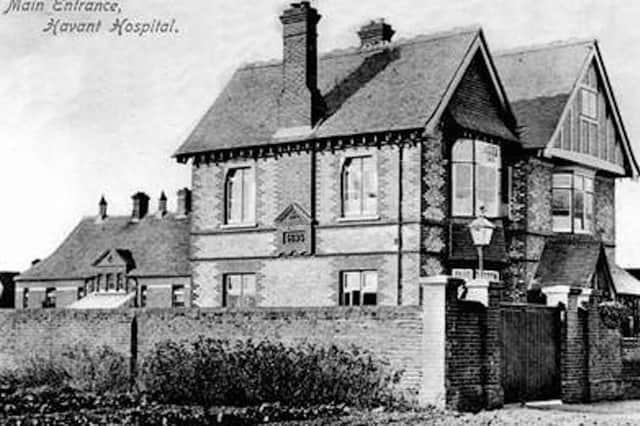Hospitals for infectious diseases? It'll never catch on... | Nostalgia


I expect most can remember Priorsdean Infectious Diseases Hospital in Portsmouth, across Milton Road from St Mary’s Hospital.
In Havant there was the Havant Joint District Hospital (Infectious Diseases Hospital).
Advertisement
Hide AdAdvertisement
Hide AdIn the Havant Borough History Booklet No15 Havant Hospitals, compiled by Ralph Cousins, he details the hospitals that existed in the borough.
The Havant hospital) existed for little more than 40 years – from 1894 to 1936. It was west of Park Road North, where the Central Retail Park now stands.
The first known provision for isolating infectious disease cases in Havant was the so-called 'Pest House’ at Stockheath. This was a cottage on the western side of the heath which, together with some adjoining land, was acquired by the Havant Union in 1858 (initially rented but later bought outright) for the reception of smallpox and other patients.
This news had obviously not been conveyed to the Poor Law Board in London, however, for in November 1859 they wrote to the Guardians to complain about the lack of provision for such cases and cited the example of one George Loton who, it was claimed, had been kept in the workhouse while infected.
Advertisement
Hide AdAdvertisement
Hide AdIn June 1876, it was decided to sell the Stockheath property and build new facilities on a piece of land adjoining the northern end of the Havant Workhouse garden. The garden was on the site now used by the fire station in Park Way. One acre of land was bought by the Workhouse Master, James Weeks, for the purpose.
By the end of 1880 it was reported that the new building was finished and ready for patients. Although it was invariably referred to as a hospital it was really no more than an isolation unit, no different to the old Stockheath ‘Pest House’, with a piped water supply, but no gas, and without any dedicated staff, medical or otherwise.
As part of the union workhouse it should really have been for the use of pauper patients only, but it is clear it also took in non-paupers, most notably the union's own relieving officer, Edward Bryan, who contracted smallpox in June 1883.
In fact the summer and autumn of that year must have seen a mini-epidemic of that disease in Havant, for the workhouse nurse, Nurse Anderson, was also struck down, and three nurses had to be hired from the Workhouse Infirmary Nurses’ Association to deal with the smallpox cases.
Advertisement
Hide AdAdvertisement
Hide AdThe full story of hospitals built around Havant and Langstone can be read in the 86-page booklet with many photographs.
Copies are available from Mr Cousins for £6 plus p&p from (023) 9248 4024.
• In 1976 News reporter Graham Dines wrote a prediction about Portsmouth in 2000.
The great amount of change that had occurred in the previous 31 years since the end of the war would no doubt continue and the dockyard and Royal Navy establishments would be the nucleus of employment potential, he said
Advertisement
Hide AdAdvertisement
Hide AdImprovements to the A3 including by-passes for Petersfield, Liphook and Hindhead with a motorway north of Bedhampton would bring London to just over an hour’s drive.
If money did not rule out the construction of the ‘essential’ east-west link through Milton Locks with outer ring car parks, motorists being forced to park and ride were likely to be given high priority to get rid of through-traffic from city streets.
Mr Dines said: ‘By the end of the century the whole of the Guildhall piazza and redevelopment will have been completed and, dare we hope, the ghastly Victorian station will have had a long-awaited facelift.’
Well, Graham’s crystal ball had much correct although some of his predictions never came to fruition.
Advertisement
Hide AdAdvertisement
Hide Ad•As a child growing up in Southsea in the 1950s Gill Preston, of Horndean, remembers South Parade Pier as ‘a wonderful place for fun and entertainment’.
She says: ‘There were weekly concerts, talent shows and the not-to-be-missed Miss Southsea contest.
‘In the evening there was always a show in the theatre and I remember seeing The Crazy Gang and June Whitfield there. Near the pier on the prom was a wonderful puppet show with 'Mr Fish' as the main character. It attracted large groups of children and adults.
‘My mother and I would pretend we were B&B visitors for the day, leaving the house after breakfast and not returning until about 6pm. We always found plenty to do along the seafront and on the pier.’
Comment Guidelines
National World encourages reader discussion on our stories. User feedback, insights and back-and-forth exchanges add a rich layer of context to reporting. Please review our Community Guidelines before commenting.